ESP LOTUS ELISE 2005 Owners Manual
[x] Cancel search | Manufacturer: LOTUS, Model Year: 2005, Model line: ELISE, Model: LOTUS ELISE 2005Pages: 205, PDF Size: 4.51 MB
Page 8 of 205
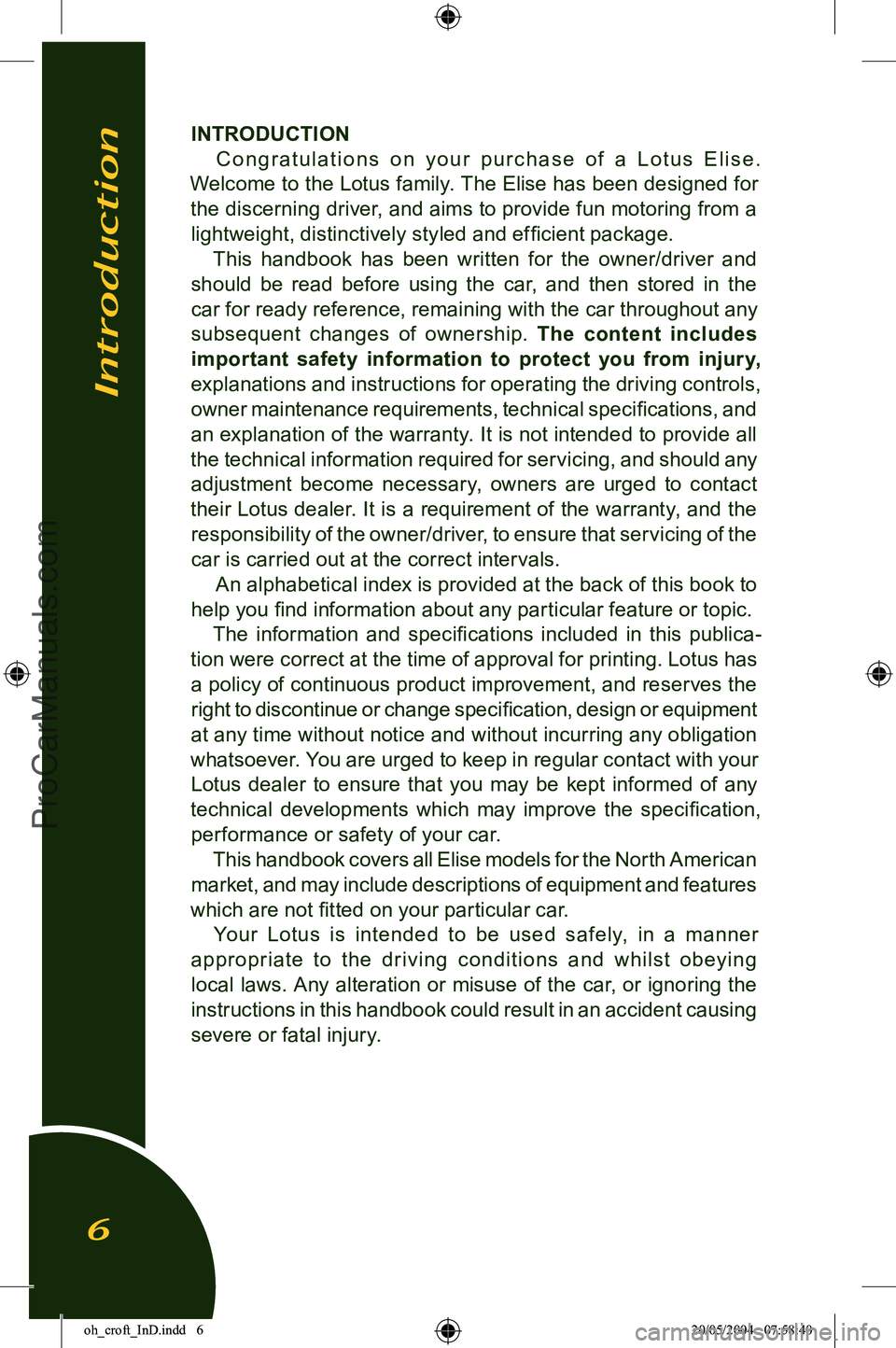
INTRODUCTIONC o n g r a t u l a t i o n s o n y o u r p u r c h a s e o f a L o t u s E l i s e .
Welcome to the Lotus family. The Elise has been designed for the discerning driver, and aims to provide fun motoring from a
lightweight, distinctively styled and efficient package. This handbook has been written for the owner/driver and
should be read before using the car, and then stored in the car for ready reference, remaining with the car throughout any
subsequent changes of ownership. The content includes
important safety information to protect you from injur y,
explanations and instructions for operating the driving controls, owner maintenance requirements, technical specifications, and
an explanation of the warranty. It is not intended to provide all
the technical information required for servicing, and should any adjustment become necessary, owners are urged to contact
their Lotus dealer. It is a requirement of the warranty, and the
responsibility of the owner/driver, to ensure that servicing of the
car is carried out at the correct intervals. An alphabetical index is provided at the back of this book to
help you find information about any particular feature or topic. The information and specifications included in this publica
-
tion were correct at the time of approval for printing. Lotus has a policy of continuous product improvement, and reserves the
right to discontinue or change specification, design or equipment
at any time without notice and without incurring any obligation
whatsoever. You are urged to keep in regular contact with your Lotus dealer to ensure that you may be kept informed of any
technical developments which may improve the specification, performance or safety of your car. This handbook covers all Elise models for the North American
market, and may include descriptions of equipment and features
which are not fitted on your particular car.
Your Lotus is intended to be used safely, in a manner
appropr iate to the dr iving c onditions and whilst obeying
local laws. Any alteration or misuse of the car, or ignoring the
instructions in this handbook could result in an accident causing
severe or fatal injury.
Introduction
6
oh_croft_InD.indd 620/05/2004 07:58:40ProCarManuals.com
Page 10 of 205
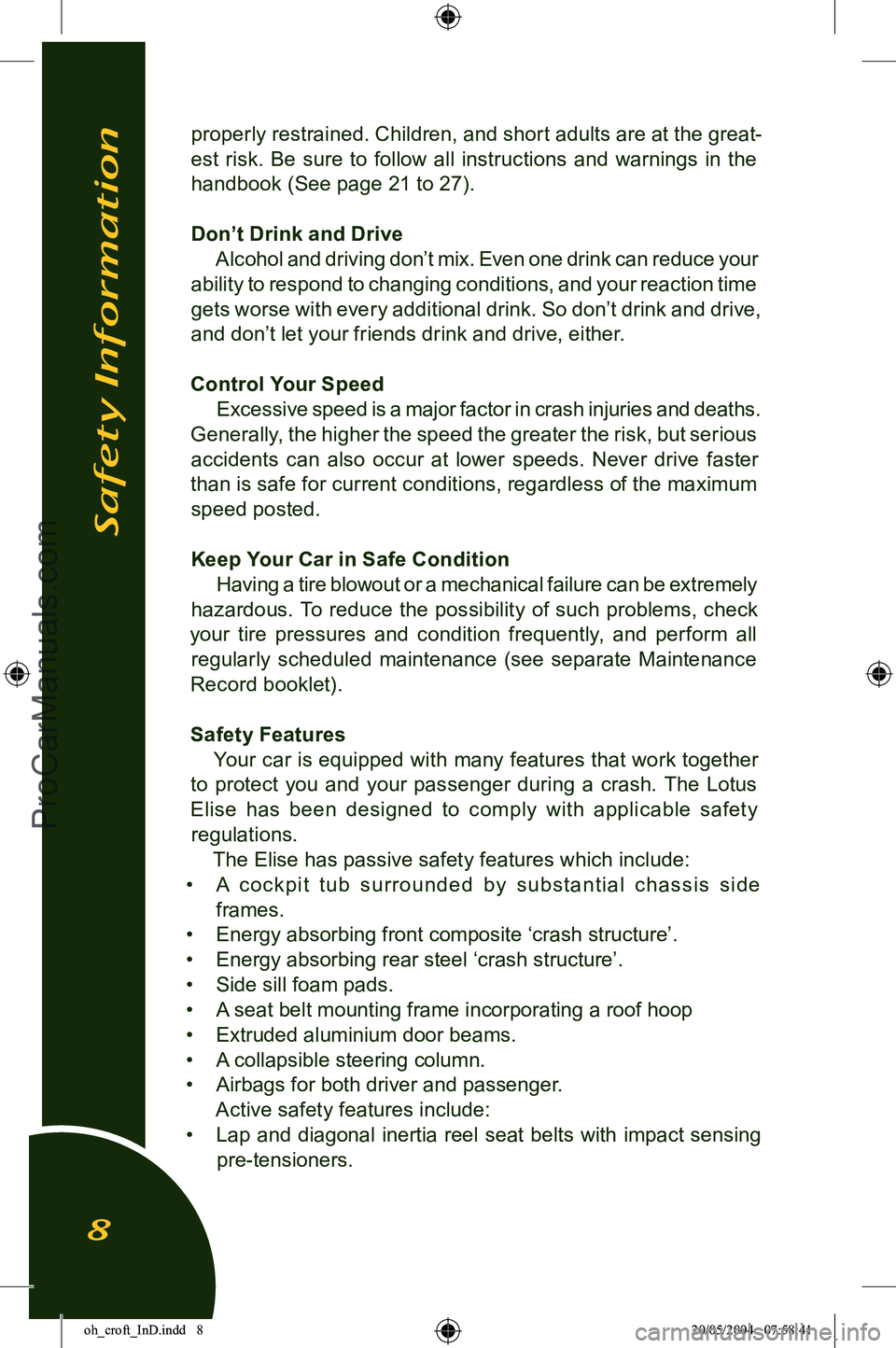
properly restrained. Children, and short adults are at the great-
est risk. Be sure to follow all instructions and warnings in the handbook (See page 21 to 27).
Don’t Drink and Drive Alcohol and driving don’t mix. Even one drink can reduce your
ability to respond to changing conditions, and your reaction time
gets worse with every additional drink. So don’t drink and drive,
and don’t let your friends drink and drive, either.
Control Your Speed Excessive speed is a major factor in crash injuries and deaths.
Generally, the higher the speed the greater the risk, but serious accidents can also occur at lower speeds. Never drive faster
than is safe for current conditions, regardless of the maximum speed posted.
Keep Your Car in Safe Condition Having a tire blowout or a mechanical failure can be extremely
hazardous. To reduce the possibility of such problems, check
your tire pressures and condition frequently, and perform all
regularly scheduled maintenance (see separate Maintenance
Record booklet).
Safety Features Your car is equipped with many features that work together
to protect you and your passenger during a crash. The Lotus Elise has been designed to comply with applicable safety regulations. The Elise has passive safety features which include:
• A cockpit tub surrounded by substantial chassis side
frames.
• Energy absorbing front
composite ‘crash structure’.
• Energy absorbing rear steel
‘crash structure’.
• Side sill foam pads.
• A seat belt mounting frame incorporating a roof hoop
• Extruded aluminium door beams.
• A collapsible steering column.
• Airbags for both driver and passenger. Active safety features include:
• Lap and diagonal inertia reel seat belts with impact sensing
pre-tensioners.
Safety Information
8
oh_croft_InD.indd 820/05/2004 07:58:41ProCarManuals.com
Page 11 of 205

• Powerful anti-lock four wheel disc brakes.
• High geared responsive steering requiring only small steering
wheel movements to alter course
• Exceptional road holding with optimised handling character
-
istics
You and your passenger cannot take full advantage of these
safety features unless you remain sitting in a proper position
and always wear your seat belt properly. In fact, some safety
features can contribute to injuries if they are not used properly. Drivers should be aware of their own limitations as well as
those of the car, and ensure that all road driving is conducted
well within both sets of capabilities, particularly on wet roads, or under adverse weather conditions.
Remember:
Driving a car requires:
• Care;
• Attention; and
• Sensible judgement.
Be aware that any motor car has the potential to cause death
or injury both to its occupants and/or other persons, and must
be used only in a responsible and cautious manner. This entire
handbook is filled with important safety information.
Please
read it carefully.
Remember:
• ALWAYS WEAR YOUR SEAT BELT.
• Never drive while under the influence of alcohol or drugs.
• Never drive when excessively tired.
• Never use mobile phones, map read or attempt other distract
-
ing activities whilst driving.
• Always obey all speed and traffic laws and regulations and never drive faster than the posted speed limit or than condi
-
tions allow.
• Be particularly careful driving on slippery or wet surfaces.
• Familiarise yourself with the car and always drive prudently, being aware of your own limitations and the limitations of the
car. Failure to operate the car properly can result in an ac
-
cident and serious injury.
Safety Information
9
oh_croft_InD.indd 920/05/2004 07:58:41ProCarManuals.com
Page 24 of 205
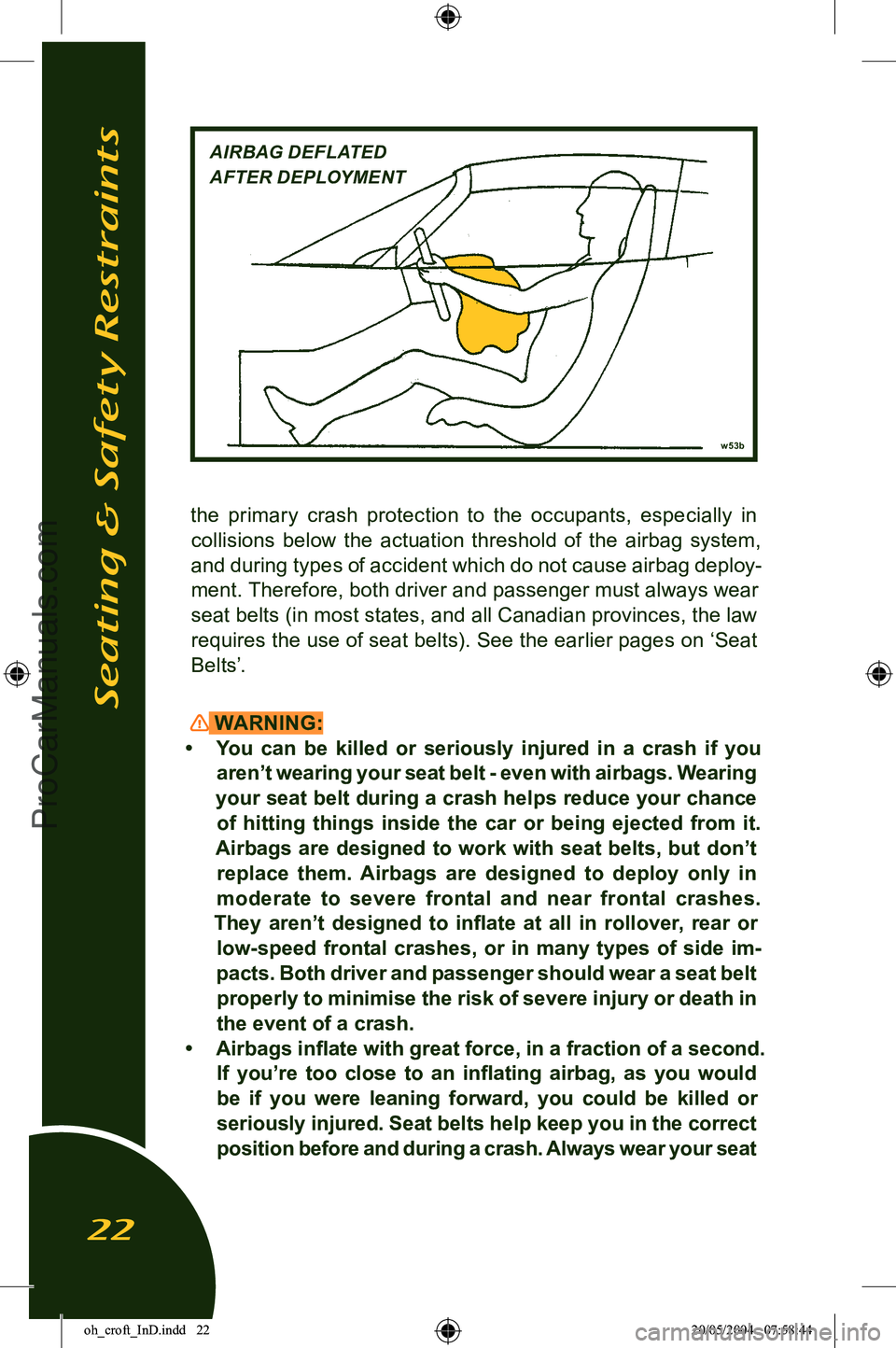
the primary crash protection to the occupants, especially in collisions below the actuation threshold of the airbag system, and during types of accident which do not cause airbag deploy
-
ment. Therefore, both driver and passenger must always wear
seat belts (in most states, and all Canadian provinces, the law
requires the use of seat belts). See the earlier pages on ‘Seat
Belts’.
WARNING:
• You can be killed or seriously injured in a crash if you aren’t wearing your seat belt - even with airbags. Wearing
your seat belt during a crash helps reduce your chance of hitting things inside the car or being ejected from it.
Airbags are designed to work with seat belts, but don’t replace them. Airbags are designed to deploy only in
moderate to severe frontal and near frontal crashes.
They aren’t designed to inflate at all in rollover, rear or low-speed frontal crashes, or in many types of side im
-
pacts. Both driver and passenger should wear a seat belt properly to minimise the risk of severe injury or death in
the event of a crash.
• Airbags inflate with great force, in a fraction of a second. If you’re too close to an inflating airbag, as you would
be if you were leaning forward, you could be killed or seriously injured. Seat belts help keep you in the correct
position before and during a crash. Always wear your seat
Seating & Safety Restraints
22
w53b
AIRBAG DEFLATED
AFTER DEPLOYMENT
oh_croft_InD.indd 2220/05/2004 07:58:44ProCarManuals.com
Page 26 of 205

• Drivers airbag circuit;
• Passenger airbag circuit;
• Seatbelts pre-tensioner circuit;
• Internal componentry of the sensor and diagnostic module.
As a bulb and circuit check, the tell tale will light briefly when
the ignition is switched on, and then go out. If the lamp lights at any other time, a fault in the airbag system is indicated, which
should be rectified without delay by your Lotus dealer.
WARNING: If the airbag tell tale does not light up as the ignition is
turned on, or remains lit for more than a few seconds, have
the fault rectified immediately by your dealer. Ignoring the
tell tale can result in serious injury or death if the airbags do not inflate when needed.
Airbag Deployment If a crash or collision causes the airbags to inflate, you may
see what looks like smoke, but is actually powder from the airbag
surface used to aid smooth deployment. Although the powder is not harmful, people with respiratory problems may experience
some temporary discomfort. If this occurs, get out of the car if possible as soon as it is safe to do so. After airbag deployment, the airbags, seat belt tensioners
and electronic control unit must be replaced by a Lotus dealer
or other suitably qualified organisation. Component parts of the airbag system are located in various
sites around the car. Any technician working on the car should be advised that the car is fitted with airbags to allow suitable
precautions to be taken.
WARNING:
• For up to 20 seconds after the ignition has been turned off and the battery disconnected, an airbag can still
inflate if improper servicing occurs. You can be injured
if you are close to an airbag when it inflates.
• Airbag system components should be serviced only by an authorised Lotus dealer. Do not work on the airbag
system yourself.
• The disposal of used airbag units is subject to stringent
Seating & Safety Restraints
24
oh_croft_InD.indd 2420/05/2004 07:58:45ProCarManuals.com
Page 29 of 205

Behaviour: It is essential that the behaviour of any child trav-
elling in the car is such that they remain correctly seated and belted, and it is the responsibility of the driver to ensure that
this occurs.
The following wording has been included to comply with
National Highway Traffic Safety Authority requirements,
however;
WARNING: Lotus str ongly recommen ds that you do not fit any type
of child seat into the Elise due to the risk of death or seri
-
ous injury if the c hild is too close to the dashboard when
the airbag inflates.
Procedure for Proper Fitment of For ward- Facing Child
Seat
A utomatic Locking Retractor: The safety belt for the passen-
ger’s seat is equipped with an automatic locking retractor that
must be used for securing a forward-facing child restraint sy
s-
tem. When activated , this retractor allows you to securely fas
-
ten the child restraint system.
Activating the Automatic Retracto r:
1. Pull the passenger seat safety belt completely
out . At this
point, the locking mechanism is activated.
2.
P lace the forward-facing child seat in the passenger seat,
using the safety belt to secure the child seat,
fo llowing the
instructions that come with the child seat
.
3. Insert the safety tongu e into the buckle and make sure that
it is properl y latched.
4. Allow the safety belt to retract until it is tight on the child seat.
You may further tighten the belt by pulling on it to allow more of
it to retract. Check to make sure the child seat is secured, and
that the belt is snug and will not pull out.
Releasing the safety bel t and child seat:
1. Unbuckle the safety belt. 2. Remove the child seat.
3. Make sure that the belt has fully retracted. At this point the
automatic locking feature is disengaged.
Seating & Safety Restraints
27
oh_croft_InD.indd 2720/05/2004 07:58:46ProCarManuals.com
Page 31 of 205
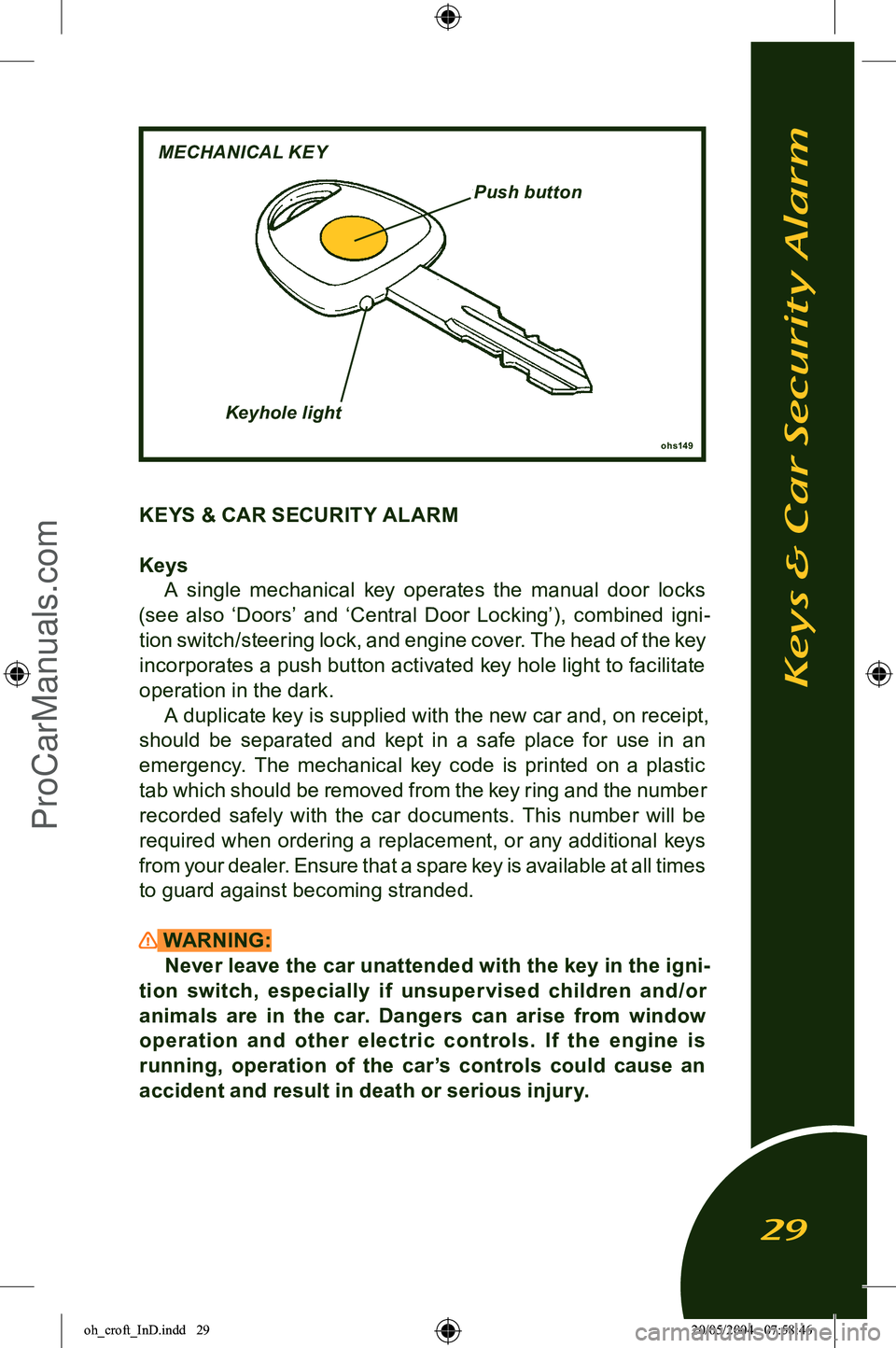
KEYS & CAR SECURITY ALARM
KeysA single mechanical key operates the manual door locks
(see also ‘Doors’ and ‘Central Door Locking’), combined igni
-
tion switch/steering lock, and engine cover. The head of the key incorporates a push button activated key hole light to facilitate
operation in the dark. A duplicate key is supplied with the new car and, on receipt,
should be separated and kept in a safe place for use in an emergency. The mechanical key code is printed on a plastic
tab which should be removed from the key ring and the number recorded safely with the car documents. This number will be
required when ordering a replacement, or any additional keys
from your dealer. Ensure that a spare key is available at all times to guard against becoming stranded.
WARNING: Never leave the car unattended with the key in the igni
-
tion switch, especially if unsuper vised children and /or animals are in the car. Dangers can arise from window
operation and other electric controls. If the engine is running, operation of the car’s controls could cause an
accident and result in death or serious injury.
ohs149
Keys & Car Security Alarm
29
MECHANICAL KEY
Push button
Keyhole light
oh_croft_InD.indd 2920/05/2004 07:58:46ProCarManuals.com
Page 44 of 205

Door WindowsIn frosty or icy weather conditions, the windows may become
frozen to the weatherstrip seals. Use a windscreen de-icer spray
to free the glass before operating the windows.
WARNING:
• Before closing a window, always check that no persons or objects will be trapped; incautious window operation
could be dangerous, especially to children. Ensure that any passenger is also made aware of this danger.
• To guard against incautious electric window operation, do not leave small children unattended in the car with
the ignition key in position.
• Do not leave children or animals in a parked car with the roof and windows closed, in hot weather conditions as
they may suffocate and/or experience heat exhaustion.
Manual Winders: Each door window may be raised or lowered by the winder
handle near the front of the door.
Electric Windows: On cars so equipped, switches for the electric window op
-
eration are mounted in the front of the door trim panels, and are operative only with the ignition switched on. To help locate the
switches in the dark, an illuminated dot is provided in the ‘up’
Entry & Comfort
42
ohs124
Illuminated
dot
Window up
Window down
oh_croft_InD.indd 4220/05/2004 07:58:50ProCarManuals.com
Page 53 of 205
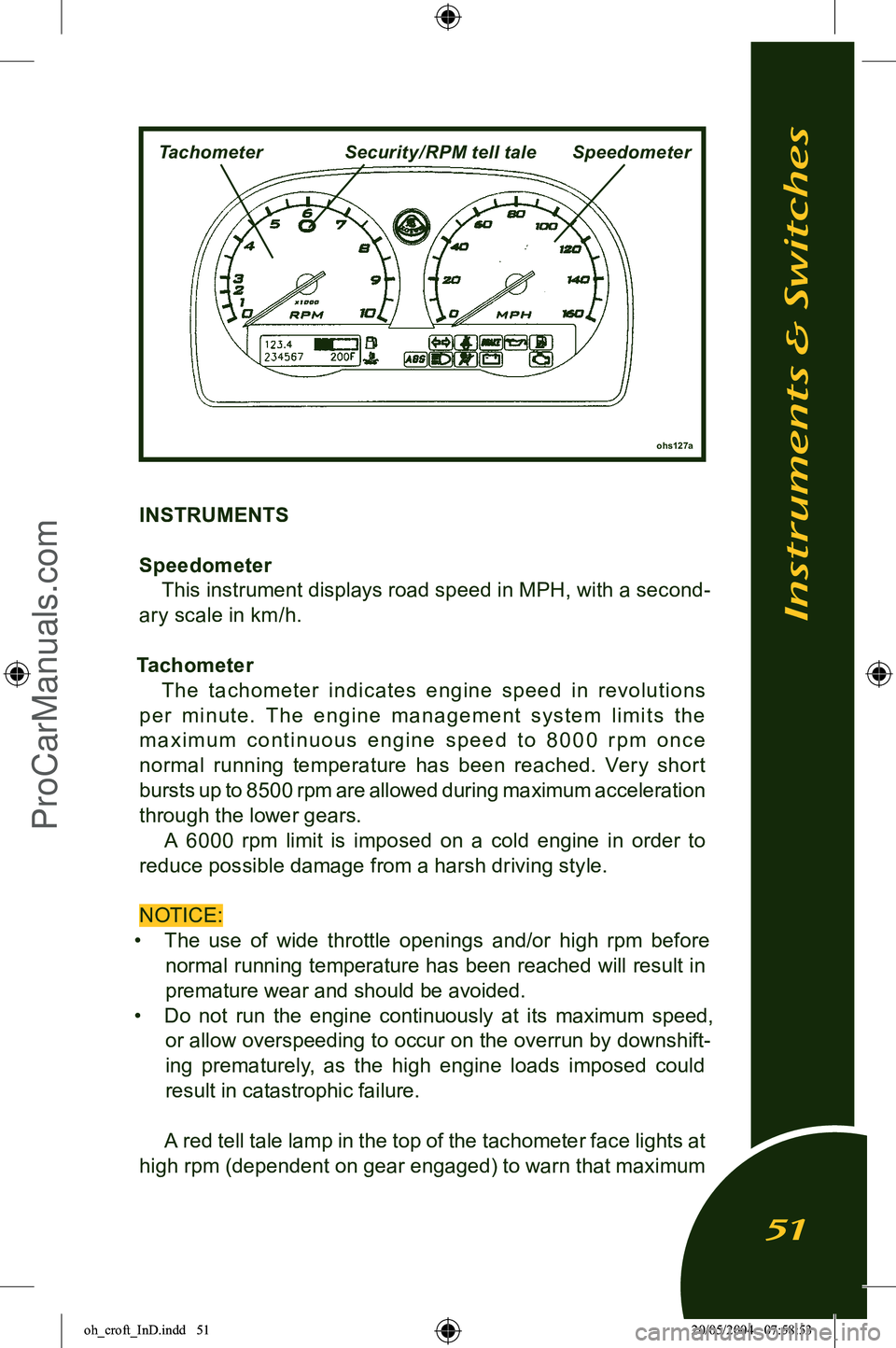
INSTRUMENTS
Speedometer This instrument displays road speed in MPH, with a second
-
ary scale in km/h.
Tachometer The t achometer indic ates engine speed in revolutions
p e r m i nu te. T h e e n g i n e m a n a g e m e nt sy s te m li m i t s t h e
m a x i m u m c o n t i n u o u s e n g i n e s p e e d t o 8 0 0 0 r p m o n c e
normal running temperature has been reached. Ver y shor t bursts up to 8500 rpm are allowed during maximum acceleration
through the lower gears. A 6000 rpm limit is imposed on a cold engine in order to
reduce possible damage from a harsh driving style.
NOTICE:
• The use of wide throttle openings and/or high rpm before
normal running temperature has been reached will result in
premature wear and should be avoided.
• Do not run the engine continuously at its maximum speed,
or allow overspeeding to occur on the overrun by downshift
-
ing prematurely, as the high engine loads imposed could
result in catastrophic failure.
A red tell tale lamp in the top of the tachometer face lights at
high rpm (dependent on gear engaged) to warn that maximum
Instruments & Switches
51
ohs127a
TachometerSecurity/ RPM tell taleSpeedometer
oh_croft_InD.indd 5120/05/2004 07:58:53ProCarManuals.com
Page 69 of 205
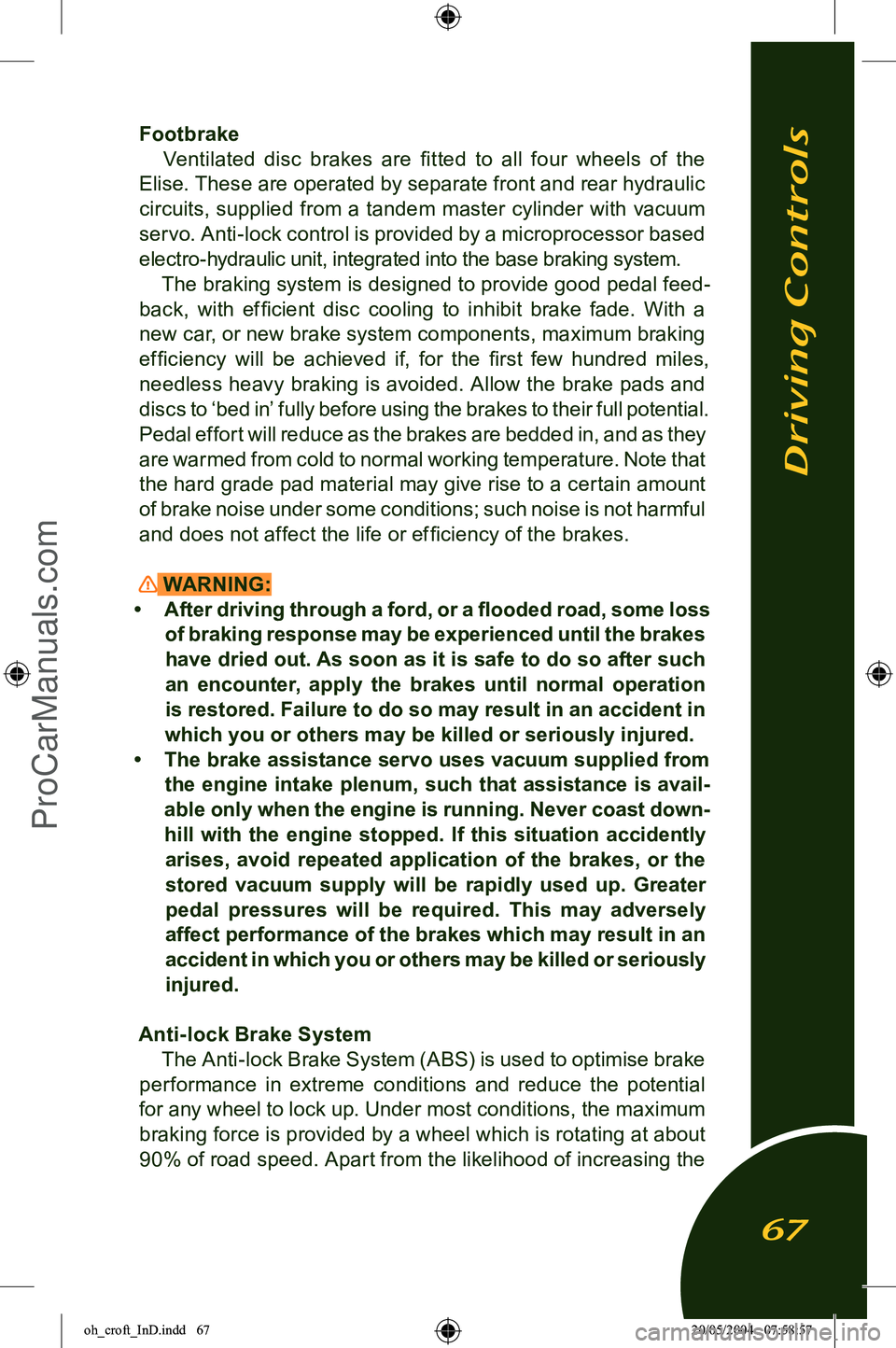
FootbrakeVentilated disc brakes are fitted to all four wheels of the
Elise. These are operated by separate front and rear hydraulic
circuits, supplied from a tandem master cylinder with vacuum
servo. Anti-lock control is provided by a microprocessor based
electro-hydraulic unit, integrated into the base braking system. The braking system is designed to provide good pedal feed
-
back, with efficient disc cooling to inhibit brake fade. With a
new car, or new brake system components, maximum braking
efficiency will be achieved if, for the first few hundred miles, needless heavy braking is avoided. Allow the brake pads and discs to ‘bed in’ fully before using the brakes to their full potential.
Pedal effort will reduce as the brakes are bedded in, and as they
are warmed from cold to normal working temperature. Note that
the hard grade pad material may give rise to a certain amount of brake noise under some conditions; such noise is not harmful
and does not affect the life or efficiency of the brakes.
WARNING:
• After driving through a ford, or a flooded road, some loss of braking response may be experienced until the brakes
have dried out. As soon as it is safe to do so after such an encounter, apply the brakes until normal operation
is restored. Failure to do so may result in an accident in
which you or others may be killed or seriously injured.
• The brake assistance servo uses vacuum supplied from the engine intake plenum, such that assistance is avail
-
able only when the engine is running. Never coast down
-
hill with the engine stopped. If this situation accidently arises, avoid repeated application of the brakes, or the
stored vacuum supply will be rapidly used up. Greater
pedal pressures will be required. This may adversely affect performance of the brakes which may result in an
accident in which you or others may be killed or seriously
injured.
Anti-lock Brake System The Anti-lock Brake System (ABS) is used to optimise brake
performance in extreme conditions and reduce the potential
for any wheel to lock up. Under most conditions, the maximum braking force is provided by a wheel which is rotating at about
90% of road speed. Apart from the likelihood of increasing the
Driving Controls
67
oh_croft_InD.indd 6720/05/2004 07:58:57ProCarManuals.com